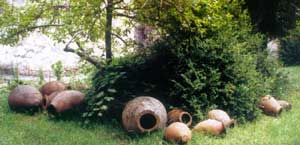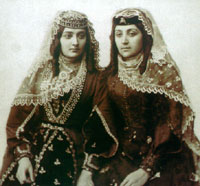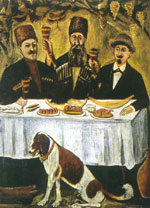

Open-handed, huge-hearted generosity, sense of community and sharing... Maybe this only happens in fairy tales, but that is how Kakheti is - the long suffering and picturesque province in eastern Georgia.
The long horizon of blue mountains, expansive valleys, gardens, forests, the Alazani River flowing at a leisurely pace, golden space enveloping you in its warmth ... you are tranquil, unhurried and it seems that nothing can trouble you. You are in Kakheti.
The Kingdom of Kakheti, the Principality of Kakheti... the status of
Kakheti, an integral part of Georgia, has changed many times throughout
history. It has attracted an excessive number of conquerors and is one
of the regions in Georgia that suffered most harshly from foreign invaders.
Kakheti was ravaged to devastation many times, yet always remained a pillar
and breadbasket for the whole country. “Rich in grain, wine, fruit, live
stock, fur, feather and fish”, wrote Vakhushti Bagrationi.
Tsivgombori Mountain divides Kakheti into Inner and Outer Kakheti.
The former was called Kakheti, the latter Kukheti. The Inner Kakheti is
watered by the Alazani River and the Outer by the Iori.
The shortage of rain and water has always been the biggest problem in
Kakheti. The two rivers cannot satisfy the vast vineyards and grain fields.
Yet this cannot compare with the devastation inflicted by the enemies -
destruction, forced deportations, religious suppression, the uprooting
of ancient vineyards. Kakheti was always the first to face the enemy, and
fought heroically to stop their advance to save the rest of Georgia
from destruction. Its people fought, toiled and never lost faith.

"Sincere, open-hearted and straightforward, Kakhetians detest slyness and flattery," wrote Iakob Gogebashvili. Vakhushti Bagrationi describes Kakhetians as "handsome, light, joyful, proud, loyal and perseverant."
A unique and robust humour is seemingly in their blood. But the sad
Urmuli folk song or Kakhetian Chakrulo and Mravalzhamieri heard in the
Alazani valley speaks most eloquently of the Kakhetian nature. These
songs bring a lump to your throat, fill you with pride for being
a Georgian, and inspire you to great deeds.
Perhaps it would be worthwhile to travel by foot throughout Kakheti’s
terrain.
It would take many days to see and reflect on everything, rather like a voyage in time - be it to Telavi or Lagodekhi, Kvareli or Sighnagi, Akhmeta or Gurjaani with all their history. But it would pay to imprint them all in mind and soul.
Telavi is the oldest and central city of Kakheti. Houses nestled against the northern slope of the Gombori mountain, ancient Christian Church of the Lord, the palace of King Erekle, and his famous baths which used to be adorned with magnificent mural.
Sighnaghi - another town-fortress and a living history museum. There is the beautiful Nekresi monastery, where Kakhetians are known to sacrifice pigs and jokingly call it the invitation to a pig’s wake. There is the Shuamta monastery which was a safe haven for women and children during times of invasion. There is David Gareja, where one of the Assyrian Fathers, St. David, settled.
The fortress town Ujarma was built in ancient times and used as a residence by Vakhtang Gorgasali. Gremi is an ancient ruin which many foreign travellers have written about.
Alaverdi, a beautiful eleventh century church. Alaverdoba is one of
the greatest religious festivals uniting Kakheti and all of Georgia.

Ikhalto Academy where Arsen Ikaltoeli worked in the 12th century and was the second most important educational centre after the Gelati Academy.
Tsinandali is one of the most romantic places in Kakheti and home of the Chavchavadze family.
Kakheti is one of the provinces richest in historical monuments and ancient historical artifacts found here. An old Georgian coin discovered in the village of Sakobiano has a special significance in the history of Georgian numismatics. This coin bares resemblance to the coin of Limizmakhe, the King of Trakia and dates back to the third century BC.
There is so much to be seen and explored in this blessed land, churches and fortresses, soaring mountains disappearing into the mist, relics, and the fertile, even medicinal, soil.
Yet the main wealth of Kakheti are the colourful Kakhetians themselves. No one can leave Kakheti without first trying chakapuli or khashlama with hot shoti bread. Throughout the region you can knock on any door for directions and find yourself invited in. Here the fairy tale really begins when one begins to feel the pleasure of drinking the Kakhetian wine.
Kakheti and vineyards are inseparable. Wine waseven offered here as a sacrifice to God. This wine was called zedashe. Zedashe means "guardian angel" and at the same time an intermediary between God and man. Zedashe kvevri (clay amphora) was never removed when the family moved to a different place to live, as the Kakhetians believed that this would bring misfortune and a curse upon the family. Zedashe was always a red wine.
Many foreigners have been fascinated by the excellent Kakhetian wine.
One guest wrote in his impressions: they drink here all year round, they
drink everywhere and always, but no one gets drunk, as one would be regarded
drunkard if seen drunk even once. Neither French, nor Spanish or Italians
equal them in drinking.
There are eighty different grapes in Kakheti, among them are Saperavi,
Rkatsiteli, Mtsvane, Budasheri and Tita. The Kakhetian wines have won numerous
international awards, yet the wine seems to taste best in the marani where
wine has been pressed.
When you think you have said everything about the province, you realise that it would indeed be impossible. How can one indeed?
Kakheti must be seen and loved...
EKA KEVANISHVILI